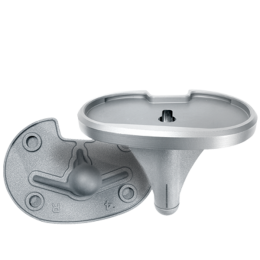Product Description
The Natural-Knee II System is a semiconstrained total knee prosthesis consisting of three anatomically designed components: the femoral, tibial, and patellar prostheses. There are four available configurations:
- Primary (primary femoral, congruent or ultracongruent tibial insert, primary or modular cemented tibial baseplate,Natural-Knee II patella)
- Revision (revision femoral with primary tibial baseplate or primary femoral with revision tibial baseplate, congruent or ultracongruent tibial insert, Natural-Knee II patella)
- Posterior Stabilized (posterior stabilized or revision femoral, posterior stabilized tibial insert, primary or modular cemented tibial baseplate, Natural-Knee II patella)
- Constrained (constrained femoral component, constrained or posterior stabilized condylar tibial insert, constrained or modular cemented tibial baseplate, Natural-Knee II patella)
Porous femoral components are manufactured from cobalt-chromium-molybdenum alloy (CoCrMo) and Cancellous- Structured Titanium™ (CSTi™) Porous Coating. Non-porous femoral components, revision posterior stabilized bars, Constrained Knee System femoral spacers and revision femoral and adapter spacers are manufactured from CoCrMo alloy.
Porous tibial baseplates are manufactured from Ti-6Al-4V alloy and CSTi Porous Coating. Modular cemented tibial baseplates and spacers are manufactured from CoCrMo alloy. Natural-Knee II revision stems are manufactured from CoCr. All other tibial baseplates, tibial baseplate spacers and revision fluted stems are manufactured from Ti-6Al-4V alloy.
All-polyethylene tibial components, which are made from ultra-high molecular weight polyethylene (UHMWPE) and contain titanium x-ray markers, are also available. Cancellous bone screws for use with tibial baseplates are made from commercially pure titanium.
Natural-Knee II patella components are available in either all-polyethylene or metal-backed versions. The all polyethylene patella is made from UHMWPE or Durasul® Highly Crosslinked Polyethylene. The metal-backed patella is made from a UHMWPE dome attached to a circular Ti-6Al-4V alloy baseplate with CSTi Porous Coating. Articular surface components are manufactured from UHMWPE or Durasul polyethylene.
Constrained Knee System
The Natural-Knee II Constrained Knee System is designed for use where the posterior cruciate ligament is absent, deficient, or has been removed at the time of surgery. Constrained Knee System polyethylene inserts are available in both constrained and posterior stabilized (PS) condylar options. A CoCr pin passing vertically from the eminence of the tibial insert to the tibial baseplate provides additional stability for the constrained condylar tibial insert. The Constrained Knee System revision adapter spacer converts the internal box geometry of the Natural-Knee II Constrained Knee System femoral component to match that of the Natural-Knee II revision femoral component.
Revision Stems/Revision Fluted Stems
Natural-Knee II revision stems and revision fluted stems fit into the intramedullary canal of either the femur or tibia and provide additional implant stability. Revision stems are straight or bowed; revision fluted stems are available in straight and offset versions. Both the revision and revision fluted stems are available in various lengths and diameters, as well as in slotted and non-slotted configurations. The stems have been designed with male taper mechanisms which are capable of mating with the stem boss of the Natural-Knee II revision femoral component, the Natural-Knee II Constrained Knee System femoral component, the Natural-Knee II modular cemented tibial baseplate, the Hinged Tibia, Hinged Femur, Non-porous and Porous Tibial Adapters of the MOST Options® system, and both the femoral and tibial components of the Apollo®Revision/Constrained Knee. Rotational stability is afforded by the key feature at the base of the taper. Further fixation to the mating component is provided by a secondary screw.
Product Brochure
Product Instrument
Indications
Contraindications
- Previous history of infection in the affected joint and/or local/systemic infection that may affect the prosthetic joint
- Insufficient bone stock
- Skeletal immaturity
- Neuropathic arthropathy
- Osteoporosis or any loss of musculature or neuromuscular disease that compromises the affected limb
- Severe instability secondary to the absence of collateral ligament integrity
- Patients with vascular deficiency at the bone site
- Patients with inadequate bone stock to assure both a firm press fit and close apposition of the cut bone surfaces to the prosthesis
- Patients with inadequate bone quality (e.g., severe osteoporosis)
- The inability to make bone cuts so as to assure both correct component position and intimate apposition of bone and prosthetic surfaces
- Lack of stability of the implanted components throughout a full range of motion






